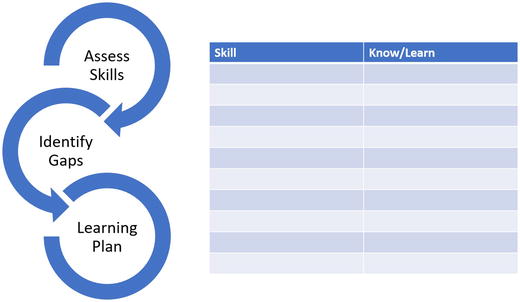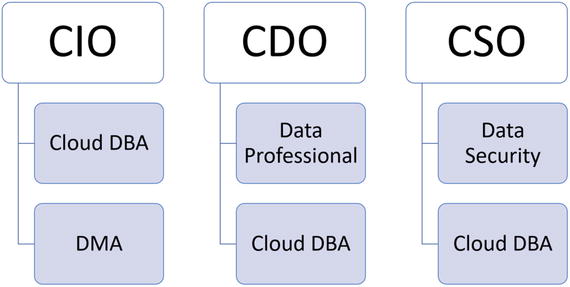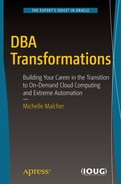We realize we have to make a change. The cloud environment and databases as a service is the next stage that is to be faced and planned on until the next disruption. With the skill sets that are gathered by DBAs, there are plenty of opportunities. With the databases in the cloud and Oracle Autonomous databases, there are processes that no long require a DBA, but the database understanding is important for the enterprise. DBAs need to transform into a couple of different roles to provide this expertise. We have a choice, and that is a great thing it means that you can choose a direction that fits with the areas you like to do. I did this a few years back in choosing security.
Security has always been an area that I have been interested in, and in working with different security products, I preferred setting up the security options and managing those. So it made sense when given the opportunity to go to the security team and handle the database security projects; it was a perfect fit. The fun part is I get to continue to learn new security skills, keep database knowledge, and work with several different teams for planning and implementing.
Tip
Decide on the skills that give you the most satisfaction in your job. There are going to be new opportunities in that area and new skills to learn too.
This is an opportunity to review the database environment, assess your skills, and put together a transformation plan.
Transformation
Throughout the chapters, we discussed the options for transformation . The work as a DBA develops many technical and soft skills. Now it is time to review this DBA Toolbelt and consider what the next steps are in this process. Figure 10-1 demonstrates that all of these endpoints start with the DBA skills and the evaluation that is now needed to get to the next stage.

Figure 10-1 Transformation from DBA skills
The DMA, Cloud DBA, Security, Data Professional, and Automation Engineer are only five paths that you can take or a combination of these. There are other paths that are available; some might be less technical and more people oriented, for example, management roles to help prepare teams to manage the cloud. There might also be even more technical roles with development or systems. These three steps will gather the details that are needed for the transformation.
Decide on the Future Direction
Evaluate Tasks
Acquire New Skills
The future direction is the endpoint of the arrows in Figure 10-1. It is also possible to work through this process with a different future direction that is not listed. Next evaluate the tasks for the roles and the skills that are your strengths, and plan for the new skills that are needed to fill in the gaps for the role.
Evaluation
Evaluation is looking at two areas. Evaluate what tasks are the most enjoyable and what would your day look like if you had a good workday. This is to understand from the previous list that has been discussed which areas are going to give you the most satisfaction from work and career choices.
This is a very brief description for each of the possible DBA roles, and the chapters on each can be used for more details as evaluating.
Database Machine Admin (DMA) – System DBA like but needs to administer storage cells and OS
Cloud DBA – Application DBA like, limited access to the server, additional monitoring responsibilities because of the cloud environment
Database Security – Security tools, auditing, access controls, and work with security and data teams
Data Professional – Big Data, Business Intelligence, data quality, and integrations
Automation – Writing and developing automation processes, monitoring jobs
These new roles can enhance your career, which will still provide support for the company’s data assets. The disruptors are rapidly changing the environment that we have been working in and the evaluation will help sort out which role fits them best without having to fear the direction of the new environment. After evaluating which new roles are ideal for you, it is time to look at current and needed skills.
New Skills
Compare the DBA’s base skill set with the other roles’ additional learning and development for different roles. The database skills are the commodity that the company wants to keep when migrations happen to the cloud environments. The DBAs should view this as an opportunity for that very reason.
What happens when we don’t develop new skills? That is when we need to have fear about the changes that are coming to the databases. The work and effort that we do can be redirected to other areas very quickly, and a company is looking to reduce costs by consolidation of servers or utilize an elastic service for the databases with the cloud. They are looking to keep the experience and support the knowledge of the data, integrations, and the business intelligence.
Planning
Not all DBAs will have the same experiences. Others might have had more time working with high availability and others working with teams building communication and relationships. These are both the technical and soft skills that are needed, but one DBA might have gaps just because of the difference in the environment and company.
Figure 10-2 demonstrates a quick sheet for helping to gather that detail around the skills and understanding the gaps that would be the ones that still need to be learned. The circles represent a continuous process. Just as we are facing a shift in technology and the databases automation, there will be more coming in the future, and this is not the last time.

Figure 10-2 Skill Learning Plan
The gaps might even be for strengthening skills. DBAs have communication, leadership, and organizational skills, but there might need to be courses in leadership or reviewing process skills to enhance what is already there.
Database security is another good example for skills and a learning plan. Security is something that DBAs do every day with access controls. There are also audit tools in place to pull activities on the databases, but there could be a need for other activity monitoring tools or writing skills development for policies and security baselines. New skills would be a mark with just a “Learn” in Figure 10-2, but increasing knowledge in a skill will be both know and learn.
Acquiring
We learned that the cloud environment provides a great sandbox for testing and exploring the cloud environment. Hands-On training is critical for the technical skill set that is needed.
Where else to acquire the desired skills? There are plenty of options, but let me suggest a few:
User Communities – IOUG for Cloud, Data Services, Analytics and Integrations, DMA. There are also security communities for the security.
Formal Training – This could be a week-long course that is focused on the skill.
Conferences – Vendor conferences such as Oracle and Microsoft will have conferences on their cloud and other database skills.
On the Job – Again this can use the cloud environments, understanding of the existing environment, and from coworkers.
Mentoring
Through the user group communities or work there is potential to learn from each other. Sharing ideas of how to architect or design a migration to the cloud could be extremely helpful: for example, having others either work through this transformation together or having the experience to partner up with those just getting started with the transition.
A person to discuss if they have seen something in the environment before like that or would plan A or plan B be better, and of course they are going to come back with plan C.
If anyone has mentored a Junior or New DBA, they realize the value in this. Much more is received from the relationship than what is put into it. It does take more than one person to make these environments work as designed.
This is important for leadership potential and develops communication and relationship building skills. Understand that it is important to be selective when it comes to mentoring. It can be through a full-out mentorship program or just a few people exchanging information to network and keep in touch as needed.
What Stays the Same
This might have been better in the last chapter, but there are a few things that comfort us when they stay the same. Not everything can change at once.
Data is data, and it will continue to grow. Because of this, data professionals should always be able to find careers. There are also careers in technology that will be available for those that continue to learn.
Figure 10-3 shows just a quick look at what is staying the same. There are going to be support and operational teams with production and test environments that we will be dealing with. It might also become an area for change further down in the future but for now this is staying the same.

Figure 10-3 Things that stay the same
Not Just a DBA
Hopefully after this discussion, this is a statement that is removed from your vocabulary. There are no longer just DBAs and at the minimum DBAs are also administering cloud databases. There are quite a few options and career path choices to make.
Figure 10-4 has the possible organizational structure of the “C” offices. This is to give you an idea of a career path and potential as well. The DBAs under CDO and CSO are more in the role of application DBA as the DBA might now be the role of supporting the application or even the cloud.

Figure 10-4 Career paths
There are a couple of different options to put in the Cloud DBA and Data Security, but this is a more typical model and just serves as a reminder of not only the technical roles and how it fits in the organizational model. There are possibilities for CIO, CDO, and CSO development, and why not, especially since the data is a very valuable commodity to the business. A person who can understand that, where it belongs in the organization, and use it for driving decisions is a strong force and valuable asset themselves in the company.
DBAs are adaptive and are constantly learning. The environments that they support can be on-premise, in the cloud, or both, but this will not matter as the DBA is now taking a look at what needs to be done for skills to manage their transformation just like they are planning migrations to the cloud or consolidations.
Conclusion
The landscape of the databases has changed. The technology developments and having cloud computing and on-demand services is increasing the challenges of for the DBA. There needs to be a transformation of the DBA to reach new levels. They already possess valuable skills with database knowledge and business processes.
The key is leveraging the existing skills and meet this challenge head-on, increasing their knowledge in cloud and data processes. There is such growth potential with the on-demand service for the DBAs. In developing DBaaS, the DBA can provide the tools to run levels of security or other configurations to build it into the service. On-Demand and Cloud Computing allow the DBAs to work more with developers and applications teams.
The career growth as a DBA requires a shift, transition to adjust course, and leverage current skills with new ones. You can decide which path you would prefer to take and build out a plan to enhance and acquire new skills.
The job of the DBA is one that very rarely has the same day twice. The DBAs are evolving out of technology disruptors. It is an interesting time to be part of the data profession as the amount of data is enormous, and all of the sources coming will continue to make this a fast and growing system.
DBAs hold the opportunity to transform into an area they want to and are excited about. Remember, security is also an option too and especially plays into some of the natural skills. DBA transformation is going to happen with the movement of the database to cloud, automation, and on-demand services.
